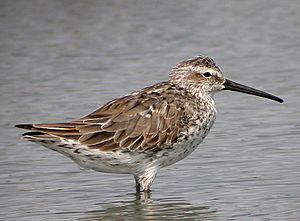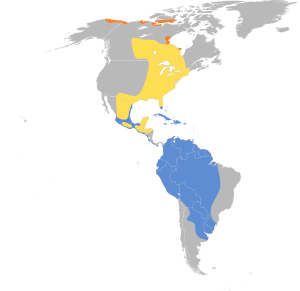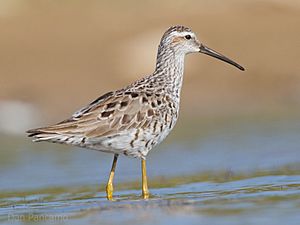Stilt sandpiper facts for kids
Quick facts for kids Stilt sandpiper |
|
|---|---|
 |
|
| Conservation status | |
| Scientific classification | |
 |
|
| Synonyms | |
|
Micropalama himantopus |
The stilt sandpiper (Calidris himantopus) is a small shorebird. These birds are known for their long legs, which help them walk in shallow water.
Their scientific name comes from Ancient Greek. The first part, kalidris, was a word Aristotle used for some grey birds found near water. The second part, himantopus, means "strap foot" or "thong foot." This name perfectly describes their long, thin legs!
Contents
Where Stilt Sandpipers Live and Travel
The stilt sandpiper makes its home and raises its young in the open arctic tundra of North America. This is a very cold, treeless area.
These birds are amazing long-distance travelers! They fly thousands of miles for the winter. They mainly spend the colder months in northern South America. Sometimes, a few get lost and are seen in places like western Europe, Japan, or northern Australia.
Stilt Sandpiper Reproduction and Life Cycle
Stilt sandpipers build their nests on the ground. The female bird usually lays three or four eggs. The male bird performs a special flight to attract a mate.
Outside of the breeding season, you will usually find these birds near inland waters. They prefer places like marshes and ponds, not open ocean coasts.
What Does a Stilt Sandpiper Look Like?
The stilt sandpiper looks a bit like the curlew sandpiper. It has a curved bill, a long neck, and a pale stripe above its eye called a supercilium. It also has a white rump (the back part of its body).
You can easily tell it apart from other sandpipers by its much longer and lighter-colored legs. These long legs are why it's called a "stilt" sandpiper! When it flies, you won't see a clear white stripe on its wings.

When they are breeding, adult stilt sandpipers look very special. Their undersides have many dark bars, and they have reddish patches above and below their eye stripe. Their back feathers are brown with darker centers.
In winter, their plumage (feathers) changes. They become mostly gray on top and white underneath. Young stilt sandpipers look like adults with their strong head pattern and brownish backs. However, their undersides are not barred, and their back feathers have white edges.
Stilt Sandpiper Size and Weight
- Length: About 7.9 to 9.1 inches (20–23 cm)
- Weight: Around 1.8 to 2.5 ounces (50-70 g)
- Wingspan: About 15 to 16 inches (38–41 cm)
What Do Stilt Sandpipers Eat?
These birds search for food in muddy areas. They use their sight to find food. They often jab their long bills into the mud, much like dowitchers do. Stilt sandpipers are often seen feeding with dowitchers.
Their main diet includes insects and other small invertebrates (animals without backbones).
See also
 In Spanish: Playero zancón para niños
In Spanish: Playero zancón para niños


